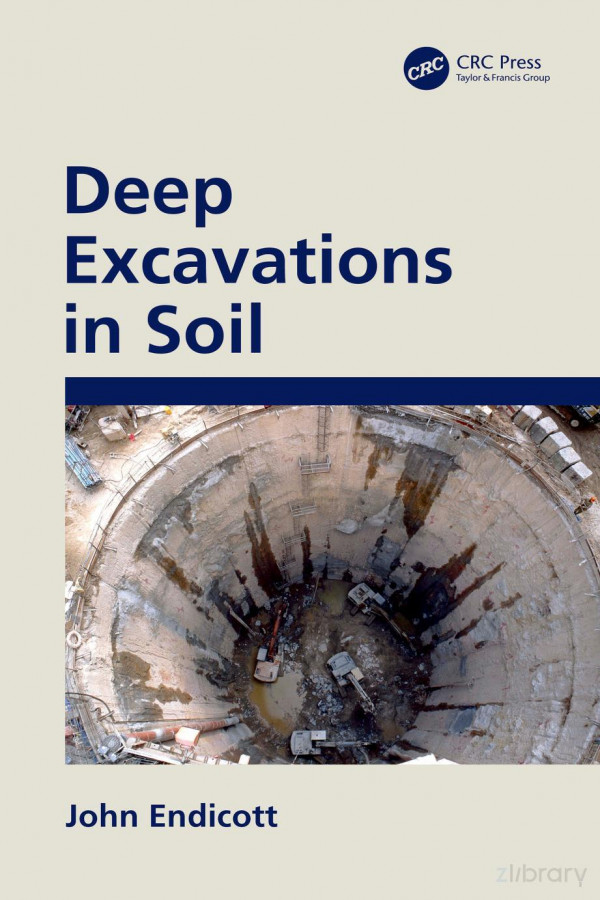Deep Excavations in Soil 1st Edition by John Endicott 1000077094 9781000077094
$50.00 Original price was: $50.00.$25.00Current price is: $25.00.
Deep Excavations in Soil 1st Edition by John Endicott – Ebook PDF Instant Download/DeliveryISBN: 1000077094, 9781000077094
Full download Deep Excavations in Soil 1st Edition after payment.

Product details:
ISBN-10 : 1000077094
ISBN-13 : 9781000077094
Author: John Endicott
The book describes the theory and current practices for design of earth lateral support for deep excavations in soil. It addresses basic principles of soil mechanics and explains how these principles are embodied in design methods including hand calculations. It then introduces the use of numerical methods including the fundamental “beam on springs” models, and then more sophisticated computer programmes which can model soil as a continuum in two or three dimensions. Constitutive relationships are introduced that are in use for representing the behaviour of soil including a strain hardening model, and a Cam Clay model including groundwater flow and coupled consolidation. These methods are illustrated by reference to practical applications and case histories from the author’s direct experience, and some of the pitfalls that can occur are discussed. Theory and design are strongly tied to construction practice, with emphasis on monitoring the retaining structures and movement of surrounding ground and structures, in the context of safety and the Observational Method. Examples are presented for conventional “Bottom-up” and “Top-down” sequences, along with hybrid sequences giving tips on how to optimise the design and effect economies of cost and time for construction. It is written for practising geotechnical, civil and structural engineers, and especially for senior and MSc students.
Deep Excavations in Soil 1st Table of contents:
1. What are deep excavations?
References
2. How deep excavations are created
2.1. Types of earth lateral support
2.1.1. Driven steel sheet piling
2.1.2. King posts and lagging
2.1.3. Contiguous bored pile walls
2.1.4. Secant piled walls
2.1.5. Diaphragm walls
2.1.6. Hand-dug caissons
2.1.7. Sprayed concrete and soil nails
2.1.8. Selection of type of wall
2.1.9. Bracing
2.2. Sequences of construction
2.2.1. Bottom-up sequence of construction
2.2.2. Top-down sequence of construction
2.2.3. Hybrid sequences of construction
2.2.4. Advantages and disadvantages of the methods
2.3. Basic theory
2.3.1. Strength of soil
2.3.2. Measurement of strength of soil
2.3.3. Stiffness of soil
2.3.4. Coefficient of subgrade reaction
2.3.5. Soil pressure
2.3.6. Limiting pressures
2.3.7. Development of lateral soil pressure
2.3.8. Numerical modelling
2.3.9. Factors of safety
2.3.10. Soil/structure interaction
References
3. Design
3.1. Design process
3.1.1. First computer programs
3.1.2. Continuum models
3.2. Ground water
3.2.1. The need to control ground water
3.2.2. Joints between wall panels
3.2.3. Seepage below walls
3.2.4. Control of ground water seepage
3.2.5. Keeping the site dry
3.3. Protection of nearby buildings and utilities
3.4. Monitoring during construction
3.5. The Observational Method
3.6. Geological risk
3.6.1. Geological risks are high
3.6.2. Mitigation of geological risk during planning
3.6.3. Mitigation of risk by ground investigation
3.6.4. Mitigation of risk during design
3.6.5. Mitigation of risk in conditions of contract
3.6.6. Mitigation of risk at time of tendering
3.6.7. Changing practices on sharing risk
3.6.8. Risk in contractual arrangements
3.6.9. Mitigation of risk during construction
3.7. Regulatory control of public safety
3.8. Planning the works
3.8.1. Desk study
3.8.2. Site-specific investigation
3.8.3. Procedures
3.8.4. Select structural form
3.9. Design
3.9.1. Design standards
3.9.2. Design considerations
3.9.3. Structural members
3.9.4. Slopes and berms
3.9.5. Soil to wall contact
3.9.6. Bulk excavation
3.9.7. Retaining walls
3.9.8. Seismicity
3.9.9. Contract period
3.9.10. Tips about detailing
3.10. Codes of practice
3.10.1. Standards and codes of practice
3.10.2. Factor of safety approach
3.10.3. Limit state approach
3.10.4. Partial factor design
3.11. Checking
3.11.1. Checking designs
3.11.2. Peer reviews
3.11.3. Legal liability
3.12. Programming activities for construction
References
4. Contracts and construction
4.1. Contracts
4.1.1. Forms of contract
4.1.2. Extent of contract
4.1.3. Contractor’s all geotechnical risks contract
4.1.4. Towards equitable sharing of risks
4.1.5. New forms of contract
4.2. Construction
4.2.1. Manuals
4.2.2. Insurance and bonds
4.2.3. Site security and safety
4.2.4. Site accommodation
4.2.5. Enabling works
4.2.6. Main work
4.2.7. Sub-contractors
4.2.8. Site staff
4.2.9. Records
4.2.10. Statutory duties
4.3. Claims and resolution
4.3.1. Claims
4.3.2. Resolution
References
5. Current practices, problems and the future
5.1. Current practices
5.1.1. Site selection
5.1.2. Site investigation and ground investigation
5.1.3. Laboratory testing
5.1.4. Computers
5.1.5. Risk
5.1.6. Control
5.1.7. Monitoring
5.1.7. The devil is in the detailing
5.1.8. Testing
5.1.9. Resolution of disputes
5.2. What can go wrong
5.2.1. Lessons
5.2.2. Classical collapses
5.2.3. Collapses of deep excavations
5.2.4. Ground water control
5.2.5. Protection of adjacent structures
5.2.6. How much rock will be encountered when excavating for diaphragm walls?
5.2.7. Wrong use of computer programs
5.2.8. Wrong information
5.2.9. Waterproofing
5.3. What can go right
5.3.1. Good engineering
5.3.2. Good projects and good planning
5.3.3. Dealing with geological risk
5.4. What next
5.4.1. More deep excavations
5.4.2. Expanding technology
5.4.3. Learning from previous experience
5.4.4. New machines, new materials
5.4.5. Complexity
People also search for Deep Excavations in Soil 1st:
deep trench excavation methods
what is excavated soil
deep excavation requirements
deep excavations
deep excavation and shoring
Tags: Deep Excavations, Soil, John Endicott
You may also like…
Science (General)
Computers - Computer Science
Computers - Computer Science
Biology and other natural sciences - Plants: Agriculture and Forestry
Romance - Other Romance Categories
In Deep (The Blackhart Brothers #2) 1st Edition Blue Saffire
Computers - Artificial Intelligence (AI)
Deep Reinforcement Learning in Action 1st Edition Alexander Zai
Biology and other natural sciences
Frontiers in Soil and Environmental Microbiology 1st Edition Suraja Kumar Nayak (Editor)
Computers - Computer Science
Deep Learning in Natural Language Processing 1st Edition by Li Deng ISBN 9811052085 9789811052088












